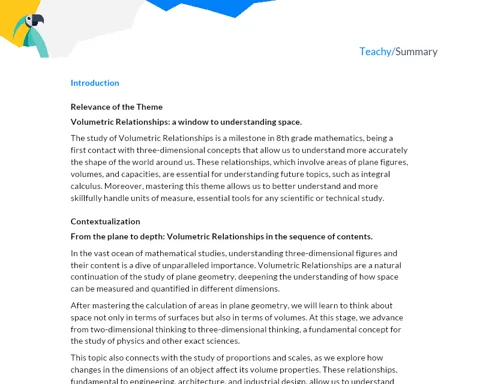INTRODUCTION TO NUMBER LINE: NATURAL NUMBERS
Relevance of the Topic:
- The number line is like a map of the world of numbers! It helps visualize and understand the position and order of natural numbers.
- Essential for learning operations like addition and subtraction, as it shows the distance between numbers.
- Basis for future concepts in mathematics, such as negative numbers and coordinates.
Contextualization:
- First contact with numbers organized in a straight line, different from counting or seeing individual numbers.
- Part of the curriculum that introduces the idea of sequence and succession in natural numbers.
- The number line is the bridge between understanding numbers individually and using them in more complex contexts.
- Used in various areas of mathematics, such as in graphs, for measurement, and even in the study of time.
Always remembering to make math fun and tangible, as we are on the adventure of discovering the incredible world of numbers! 🧭✨---
THEORETICAL DEVELOPMENT: NUMBER LINE AND NATURAL NUMBERS
Components:
- Line: A continuous line without a beginning or end, which allows us to organize numbers.
- Points: Marks or traces on the line representing natural numbers.
- Origin: The starting point on the line, usually represented by the number 0.
- Distance between points: The space between two consecutive points, which is always equal on the number line, showing that the numbers are equally spaced.
Key Terms:
- Natural Numbers: Positive integers used for counting (0, 1, 2, 3, ...).
- Number Sequence: Order in which numbers appear on the number line, from the smallest to the largest quantity.
- Successor: The next number in the number sequence. Example: The successor of 4 is 5.
- Predecessor: The number before another in the number sequence. Example: The predecessor of 4 is 3.
Examples and Cases:
-
Building a Simple Number Line:
- Draw a horizontal straight line.
- Mark a point and write the number 0 below. This is the origin point.
- From the origin point, make equally spaced marks for the other natural numbers, writing the corresponding number below each mark.
- Note: It is the constant distance between the points that allows us to see that they represent a consecutive and ordered sequence.
-
Finding Numbers on the Line:
- To locate the number 5, start at the origin point (0) and count 5 spaces to the right.
- The point where you stop is where the number 5 resides on the number line.
-
Identifying the Successor:
- Look at the number 7 on the number line.
- The next point to the right is 8. The number 8 is the successor of 7.
-
Identifying the Predecessor:
- Look at the number 10 on the number line.
- The point immediately to the left is 9. The number 9 is the predecessor of 10.
At the end of this exploration, the number line will not only be a line with numbers, but a path that shows us the beautiful order of natural numbers, ready to be used in many mathematical adventures! 🌟📏
DETAILED SUMMARY
Key Points:
- Map of Numbers: The number line is a guide that shows where each natural number is located.
- Linear Structure: Numbers are positioned on a straight line, demonstrating order and uniformity.
- Origin as Starting Point: The number 0 is the basis to start our journey along the number line.
- Standardized Distance: Each step on the number line is equal, showing the number sequence fairly and consistently.
- Identification of Successors and Predecessors: The number line facilitates the visualization of the number that comes next (successor) and the number that comes before (predecessor).
- Sequential Organization: Numbers are arranged from smallest to largest, facilitating the understanding of quantities and the execution of operations.
Conclusions:
- Visual Relationship with Numbers: The number line allows us to visualize numbers clearly and in order, making it easier to understand the relationship between them.
- Importance of Sequence: The number sequence is essential to understand mathematical concepts and perform basic operations.
- Foundation for Other Areas of Mathematics: Understanding the number line paves the way to learn about graphs, measurements, and other more advanced topics.
Exercises:
- Locating Numbers: Draw a number line and mark the numbers from 0 to 10. Ask students to point out where the number 6 is located.
- Finding Successors: Show a number on the number line and ask students to identify the successor of that number.
- Finding Predecessors: Show a number on the number line and ask students to identify the predecessor of that number.
With these exercises and the exploration of the number line, students are on the right path to becoming true explorers of the world of natural numbers! 🎯🚀



